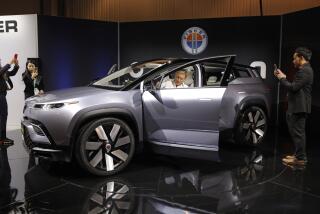U.S. sales a question as Nissan launches Datsun brand with tiny Go
Three decades after the last Datsun left a dealership, Nissan is just about to put the brand back on the road.
It’s in the final stages of readying production of the Datsun Go, a small hatchback that will sell in India and other emerging auto markets early next year. It also plans to announce a second model to the Datsun lineup in advance of an auto show in Indonesia next week.
While famous for well-engineered, sporty cars such as the 240Z and Datsun 510 sedan here in the U.S., this second incarnation of the famous nameplate is purely a budget play. The base version of the Go will start at about $6,300.
Althought Nissan showed off the new Datsun at a press event in Irvine earlier this week, don’t expect it to be available in the U.S. anytime soon or anywhere near that price. Initial sales are targeted for India, Indonesia, Russia and South Africa.
“The level of passion and memories for Datsun in the U.S. is amazing, so it is kind of heartbreaking for me to say that there is no plan to bring Datsun to the U.S. at this time,” said Vincent Cobee, the brand’s corporate vice president.
But Cobee said Nissan knows that as a business, “we never say never.” After all, the automaker once killed the brand.
Nissan also doesn’t plan to bring back any of the old Datsun model names. The new models are being designed to fit specific markets and price points.
While the styling of the Go was done in Japan, engineering for the project and the hiring of suppliers was conducted in India to keep the price down. It will be built at a joint Renault-Nissan plant near Chennai, India.
Photos: Here’s what the new Datsun looks like.
It’s a spartan car by American standards.
The Go is powered by a tiny three-cylinder, 68-horsepower engine. It has just one windshield wiper. It is a right-hand-drive vehicle and comes only with a manual transmission. The base model has crank windows.
At just 13 inches in diameter, the wheels look more like what goes on a golf cart rather than a standard American-built car, such as its much larger sibling, the Nissan Altima. The interior door panels are made from a durable plastic that resembles the material used in a Rubbermaid children’s climbing toy.
Power windows and a smartphone cradle with a USB port are an upgrade. The car has five seatbelts – allowing three people to sardine into the back seat, but no airbags. There are cloth seats without even a stich of faux leather trim.
Nissan strategists believe there is a big market for basic, inexpensive cars. Cobee said Nissan wants to cash in on the type of fast growth the industry has witnessed in China, where new car sales jumped from a meager 1 million in 2000 to about 18 million last year.
Cars targeted toward these emerging markets don’t translate into U.S. sales, said Karl Brauer, the senior analyst at Kelley Blue Book.
As Nissan’s budget brand, “the cost structure of what it takes to pass all the U.S. standards makes it hard for them to do that in this country,” Brauer said.
Moreover, Nissan already has a tiny, low-cost car in this market, the Versa. With a starting price just below $12,000 before delivery charges, the subcompact is the least expensive new car sold in the U.S., Brauer said.
Still, he wouldn’t entirely rule out a U.S. Datsun.
“They might be able to do something like Fiat or Mini with strong marketing to revive the brand and offering a really good value equation, even something at $9,000,” Brauer said.
The brand dates from 1931 as the nameplate of Japan’s DAT Motorcar Co., which was purchased by Nissan in 1933. The car was first known as a Datson, and later changed to Datsun.
About 20 million Datsuns sold in 190 countries over about 50 years before Nissan phased out the nameplate in 1981.
While that U.S. growth helped transform Nissan into a global automotive manufacturer, the company decided to sell all its cars under the same name, no matter the market. But that strategy lasted only a few years until Nissan launched its Infiniti luxury division in 1989.
“The original concept for Datsun years ago was to create a compact, durable car for the Japanese market,” said Tomonori Muto, Datsun’s international marketing manager. “Now we are trying this again in other countries.”
Follow me on Twitter (@LATimesJerry), Facebook and Google+.
ALSO:
Tesla Model S outsells Jaguar, Porsche and Volvo in California
Taxes or gasoline: What drives up cost of driving in California?
GM says California’s tough zero emission vehicle goals reachable








